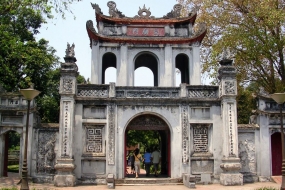The Khuê Văn Pavilion, located in the temple concourse, contains 83 stone stele which bear the names of successful candidates in national examinations held over a period of 300 years (1484-1787), whilst artifacts on display in various buildings illustrate the history of the temple. An important part of the site known as Thái Học (Giám College) was demolished in the 19th century to make way for a royal temple, but the latter was destroyed in 1946 during fighting with the French.
In 1999-2000 the original Thái Học was rebuilt, according to Lê dynasty specifications and using traditional materials, with financial assistance from Petrovietnam and COMVIK (Sweden). It now houses a small exhibition on the development of the site and of the Confucian system of education which dominated Việt Nam from the 11th century to the final sinologist examinations in 1918. The new building is also used to hold scientific seminars, lectures on key cultural figures and ceremonies granting bachelor and doctorate certificates to scholars nationwide. A library of books in chữ Hán (classical Han Chinese, also known as chữ nho) as well as new publications on Vietnamese cultural norms and values, are being developed. {itpsharepoint}


